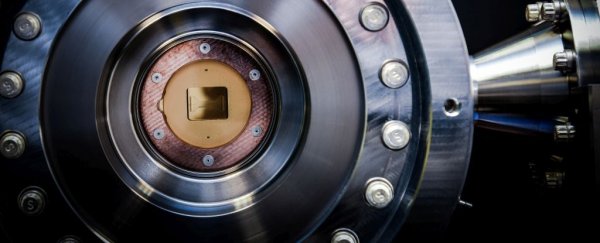
This Weird New Phase of Matter Seems to Occupy 2 Time Dimensions
MICHELLE STARR
21 JULY 2022
A new phase of matter has been observed in a quantum computer after physicists pulsed light on its qubits in a pattern inspired by the Fibonacci sequence.
If you think that's mind-boggling, this weird quirk of quantum mechanics behaves as though it has two time dimensions, instead of one; a trait that scientists say makes the qubits more robust, able to remain stable for the entire duration of the experiment.
This stability is called quantum coherence, and it's one of the main goals for an error-free quantum computer – and one of the most difficult to achieve.
The work represents "a completely different way of thinking about phases of matter," according to computational quantum physicist Philipp Dumitrescu of the Flatiron Institute, lead author of a new paper describing the phenomenon.
"I've been working on these theory ideas for over five years, and seeing them come actually to be realized in experiments is exciting."
Quantum computing is based on qubits, the quantum equivalent of computing bits. However, where bits process information in one of two states, a 1 or a 0, qubits can be both simultaneously, a state known as quantum superposition.
The mathematical nature of that superposition can be incredibly powerful from a computational standpoint, making short work of problem solving under the right circumstances.
But the blurred, unsettled nature of a series of qubits also depends on how their undecided states relate to one another – a relationship called entanglement.
Frustratingly, qubits can entangle with just about anything in its environment, introducing errors. The more delicate a qubit's blurry state is (or the more chaos there is in its environment), the greater the risk of it losing this coherence.
Improving coherence to the point of viability is likely a multi-tactic approach to clear a significant hurdle standing in the way of a functional quantum computer – every little bit makes a difference.
"Even if you keep all the atoms under tight control, they can lose their quantumness by talking to their environment, heating up or interacting with things in ways you didn't plan," Dumitrescu explained.
"In practice, experimental devices have many sources of error that can degrade coherence after just a few laser pulses."
Enforcing a symmetry can be one means of protecting qubits from decoherence. Rotate a plain old square ninety degrees, and it's still effectively the same shape. This symmetry protects it from certain rotational effects.
Tapping qubits with evenly spaced laser pulses ensures there's a symmetry based not in space, but time. Dumitrescu and his colleagues wanted to know if they could dial up this effect by adding, not symmetrical periodicity, but asymmetrical quasiperiodicity.
This, they theorized, would add not one time symmetry, but two; one effectively buried inside the other.
The idea was based on earlier work by the team that proposed the creation of something called a quasicrystal in time, rather than space. Where a crystal is made of a symmetrical lattice of atoms that repeats in space, like a square grid jungle gym or a honeycomb, the pattern of atoms on a quasicrystal is non-repeating, like a Penrose tiling, yet still ordered.
The team conducted their experiment on a cutting-edge commercial quantum computer designed by Quantinuum, a quantum computing company. This beast employs for its qubits 10 atoms of ytterbium (one of the elements of choice for atomic clocks). These atoms are held in an electrical ion trap, from which laser pulses can be employed to control or measure them.
Dumitrescu and colleagues created a sequence of laser pulses based on Fibonacci numbers, where each segment is the sum of the two previous segments. This results in a sequence that is ordered, but doesn't repeat, just like a quasicrystal.
Quasicrystals can be mathematically described as lower-dimensional segments of higher-dimensional lattices. A Penrose tiling can be described as a two-dimensional slice of a five-dimensional hypercube.
In the same way, the team's laser pulses can be described as a one-dimensional representation of a two-dimensional pattern. Theoretically, this meant that it could potentially impose two time symmetries on qubits.
The team tested their work by flashing lasers at the ytterbium qubit array, first in a symmetrical sequence, then quasiperiodically. They then measured the coherence of the two qubits on either end of the trap.
For the periodic sequence, the qubits were stable for 1.5 seconds. For the quasiperiodic sequence, they remained stable for 5.5 seconds – the duration of the experiment.
The additional time symmetry, the researchers said, added another layer of protection against quantum decoherence.
"With this quasi-periodic sequence, there's a complicated evolution that cancels out all the errors that live on the edge," Dumitrescu said.
"Because of that, the edge stays quantum-mechanically coherent much, much longer than you'd expect."
The work isn't close to being ready for integration into functional quantum computers, but it does represent an important step towards that goal, the researchers said.
The research has been published in Nature.
https://www.sciencealert.com/a-new-quantum-phase-of-matter-behaves-like-it-has-two-time-dimensions
Thanks to: https://www.sciencealert.com






 Sat Mar 23, 2024 11:33 pm by globalturbo
Sat Mar 23, 2024 11:33 pm by globalturbo

